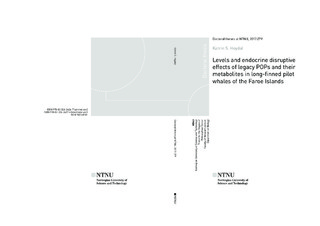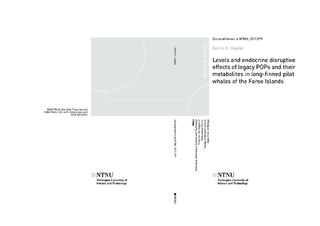| dc.contributor.author | Hoydal, Katrin S. | |
| dc.date.accessioned | 2017-11-14T14:42:51Z | |
| dc.date.available | 2017-11-14T14:42:51Z | |
| dc.date.issued | 2017 | |
| dc.identifier.isbn | 978-82-326-2627-4 | |
| dc.identifier.issn | 1503-8181 | |
| dc.identifier.uri | http://hdl.handle.net/11250/2466260 | |
| dc.description.abstract | Pilot whales (Globicephala melas) in the Northeastern part of the Atlantic Ocean have high body concentrations of persistent organic pollutants (POPs), such as polychlorinated biphenyls (PCBs), organochlorinated pesticides (OCPs) and polybrominated diphenyl ethers (PBDEs). These compounds and their biological biotransformation products, i.e. metabolites, have been linked to serious health effects in mammals, including effects on the reproductive system, due to disruption of their endocrine systems. The aim of this study was to analyse levels of POPs and their metabolites in pilot whales from Faroese waters and to investigate the possible effects of the POP exposure on steroid hormones, thyroid hormones, and vitamin A, E and D, which have been suggested as sensitive biomarkers for endocrine disruptive effects. In addition, the ability of the whales to biotransform the POPs was investigated. The possible effects of the POPs on the biomarkers were studied by analysing correlative relationships between the POP concentrations and the biomarkers, and furthermore, the POP concentrations were compared to toxic reference values (TRVs) which have been suggested for toxic effects in marine mammals.
The analyses confirmed that the pilot whales from the Faroe Islands had high concentrations of POPs in their tissues, exceeding some TRVs which have been suggested for toxic effects in marine mammals, but low concentrations of metabolites. In addition low activities of phase I and phase II enzymes were measured, indicating that the pilot whales have low ability to biotransform POPs, although they expressed enzymes of the CYP1A, 2B and 3A families. The biomarkers for endocrine disrupting effects did generally not show high correlative relationships with the POP concentrations, but differed with age and sex of the whales, indicating that that these are important confounding factors. Nevertheless, some correlations were found between single POPs and hormones and vitamins, suggesting that POPs may have some effect on the vitamin and hormone homeostasis in pilot whales.
From the study it could be concluded, that although the pilot whales from the Faroe Islands were exposed to relatively high concentrations of POPs, and the concentrations exceeded some of the toxic reference levels suggested for effects on marine mammals, the POPs did not seem to have clear overall negative effects on the analysed biomarkers. This indicates that the POPs in the Faroe Island population of pilot whales may be below threshold levels for negative effects on steroid and thyroid hormones and vitamin A levels. This could possibly be related to the apparent low biotransformation of POPs in pilot whales and thus their low concentrations of metabolites, such as OH-PCBs and OH-PBDE, which often have been linked to the endocrine disrupting effects of POPs. | nb_NO |
| dc.language.iso | eng | nb_NO |
| dc.publisher | NTNU | nb_NO |
| dc.relation.ispartofseries | Doctoral theses at NTNU;2017:279 | |
| dc.relation.haspart | Paper 1:
Hoydal, Katrin Sunniva; Letcher, Robert J; Blair, David AD; Dam, Maria; Lockyer, Christina; Jenssen, Bjørn Munro.
Legacy and emerging organic pollutants in liver and plasma of long-finned pilot whales (Globicephala melas) from waters surrounding the Faroe Islands. Science of the Total Environment 2015 ;Volum 520. s. 270-285,
https://doi.org/10.1016/j.scitotenv.2015.03.056 | |
| dc.relation.haspart | Paper 2:
Hoydal, K.S., Jenssen, B.M., Letcher, R.J., Dam, M., Arukwe, A. Hepatic Phase I and II
Biotransformation Responses and Contaminant Exposure in Long-Finned Pilot Whale from the
Northeastern Atlantic. | |
| dc.relation.haspart | Paper 3:
Hoydal, K.S., Styrishave, B., Ciesielski, T.M., Letcher, R.J., Dam, M., Jenssen, B.M. Steroid
Hormones and Persistent Organic Pollutants in plasma from Northeastern Atlantic Pilot whales. | |
| dc.relation.haspart | Paper 4:
Hoydal, Katrin Sunniva; Ciesielski, Tomasz Maciej; Borrell, Asuncion; Wasik, Andrzej; Letcher, Robert J; Dam, Maria; Jenssen, Bjørn Munro.
Relationships between concentrations of selected organohalogen contaminants and thyroid hormones and vitamins A, E and D in Faroese pilot whales. Environmental Research 2016 ;Volum 148. s. 386-400, https://doi.org/10.1016/j.envres.2016.04.012 | |
| dc.relation.haspart | Paper 5:
Hoydal, K.S., Jenssen, B.M., Ciesielski, T.M., Letcher, R.J., Dam, M., Arukwe, A. Changes in
CYP26 expression and vitamin A levels in relation to contaminant levels in Faroese pilot whales. | |
| dc.title | Levels and endocrine disruptive effects of legacy POPs and their metabolites in long-finned pilot whales of the Faroe Islands | nb_NO |
| dc.type | Doctoral thesis | nb_NO |
| dc.subject.nsi | VDP::Mathematics and natural science: 400::Basic biosciences: 470 | nb_NO |
| dc.description.localcode | Digital fulltext not available | nb_NO |

